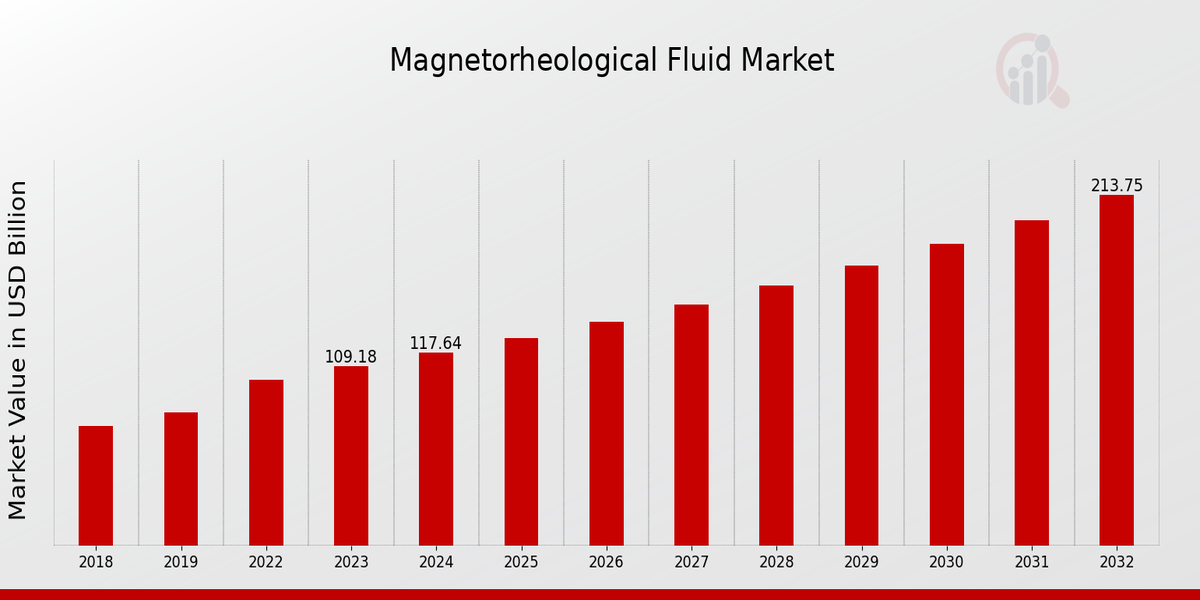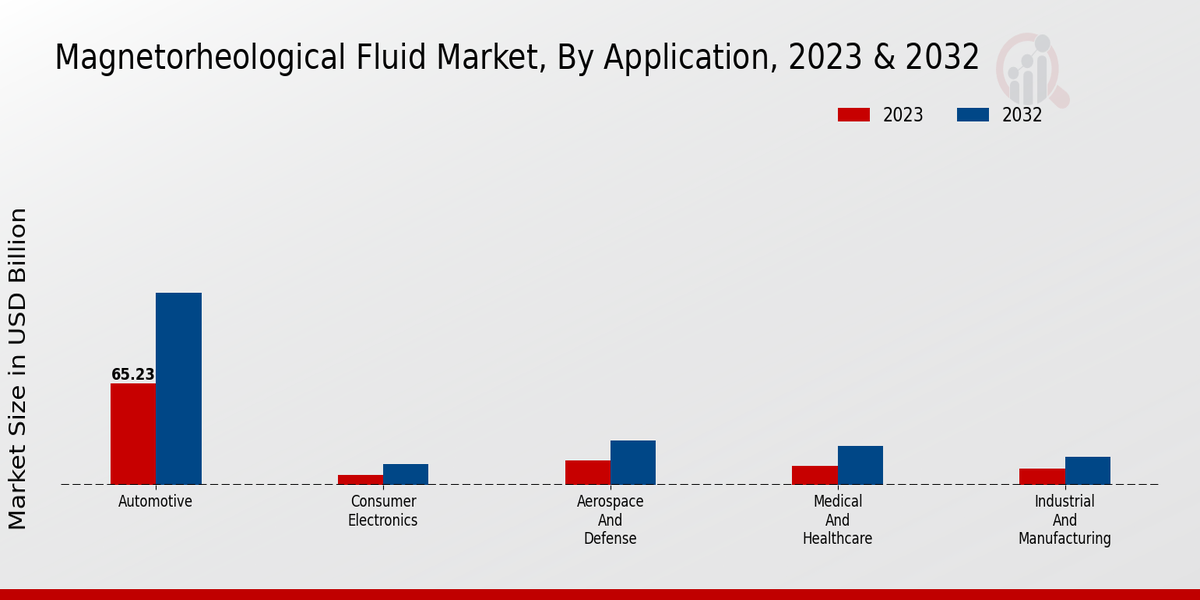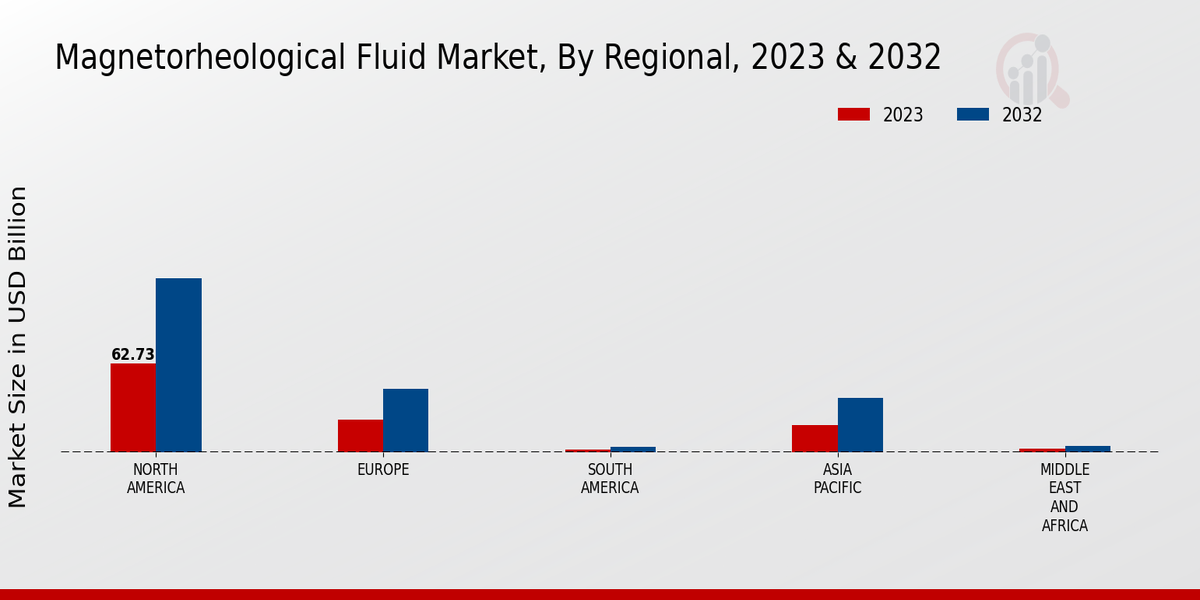Magnetorheological Fluid Market Overview
Magnetorheological Fluid Market Size was estimated at 101.33 (USD Billion) in 2022. The Magnetorheological Fluid Market is expected to grow from 109.18(USD Billion) in 2023 to 213.66 (USD Billion) by 2032. The Magnetorheological Fluid Market CAGR (growth rate) is expected to be around 7.75% during the forecast period (2024 - 2032).
Key Magnetorheological Fluid Market Trends Highlighted
The magnetorheological fluid (MRF) market is anticipated to witness significant growth in the coming years due to its increasing adoption in various industries. The automotive sector is a major driver of this growth, with MRFs being utilized in dampers, clutches, and vibration isolators. The demand for MRFs in aerospace and defense applications, such as flight control systems and shock absorbers, is also contributing to the market expansion.
Recent trends in the MRF market include a growing focus on miniaturization and integration, as well as the development of environmentally friendly and biocompatible MRFs. The emergence of smart and autonomous systems is further driving the adoption of MRFs, as they offer precise and reliable control capabilities. Key opportunities for growth lie in the exploration of MRFs with enhanced properties, such as faster response times, higher shear stresses, and improved temperature stability.

Source Primary Research, Secondary Research, MRFR Database and Analyst Review
Magnetorheological Fluid Market Drivers
Rising Demand for MR Fluids in Automotive Applications
The automotive industry is a major driver of growth for the Magnetorheological Fluid Market Industry. MR fluids are increasingly used in automotive applications such as shock absorbers, clutches, and brakes. This is due to the unique properties of MR fluids, which allow them to change their viscosity in response to a magnetic field. This makes them ideal for use in applications where precise control of damping or vibration is required. The growing demand for MR fluids in automotive applications is expected to continue to drive growth in the Magnetorheological Fluid Market Industry.
Increasing Adoption of MR Fluids in Aerospace and Defense Applications
MR fluids are also finding increasing use in aerospace and defense applications. In aerospace applications, MR fluids are used in flight control systems, landing gear, and vibration isolation systems. In defense applications, MR fluids are used in armor, shock absorbers, and other protective systems. The growing adoption of MR fluids in aerospace and defense applications is expected to contribute to the growth of the Magnetorheological Fluid Market Industry.
Technological Advancements and New Product Development
The Magnetorheological Fluid Market Industry is also being driven by technological advancements and new product development. Researchers are constantly working to develop new and improved MR fluids with enhanced properties. This is leading to the development of new applications for MR fluids, which is further driving growth in the market. Additionally, the development of new manufacturing techniques is making it possible to produce MR fluids at a lower cost, which is also contributing to the growth of the market.
Magnetorheological Fluid Market Segment Insights
Magnetorheological Fluid Market Application Insights
Application Segment Insight and Overview The Magnetorheological Fluid market is segmented by application into Automotive, Aerospace and Defense, Medical and Healthcare, Industrial and Manufacturing, and Consumer Electronics. Among these segments, Automotive holds the largest market share due to the increasing adoption of MR fluids in automotive suspension systems, clutches, and brakes. The Magnetorheological Fluid market revenue in the Automotive segment is projected to reach USD 65.23 billion by 2024, exhibiting a CAGR of 8.5% during the forecast period.
Aerospace and Defense is another significant segment in the Magnetorheological Fluid market. MR fluids are used in aerospace applications such as flight control systems, landing gear, and vibration damping systems. The increasing demand for advanced aircraft and defense systems is expected to drive the growth of this segment. The Magnetorheological Fluid market revenue in the Aerospace and Defense segment is estimated to reach USD 15.67 billion by 2024, with a CAGR of 9.2% during the forecast period. Medical and Healthcare is a growing segment in the Magnetorheological Fluid market.
MR fluids are used in medical applications such as surgical robots, MRI scanners, and prosthetic devices. The increasing demand for minimally invasive surgeries and advanced medical imaging technologies is expected to fuel the growth of this segment. The Magnetorheological Fluid market revenue in the Medical and Healthcare segment is projected to reach USD 12.34 billion by 2024, exhibiting a CAGR of 10.1% during the forecast period. Industrial and Manufacturing is another important segment in the Magnetorheological Fluid market. MR fluids are used in industrial applications such as vibration isolation, polishing, and damping systems.
The increasing demand for automation and precision manufacturing is expected to drive the growth of this segment. The Magnetorheological Fluid market revenue in the Industrial and Manufacturing segment is estimated to reach USD 10.42 billion by 2024, with a CAGR of 8.9% during the forecast period. Consumer Electronics is a niche segment in the Magnetorheological Fluid market. MR fluids are used in consumer electronics applications such as speakers, headphones, and haptic devices. The increasing demand for immersive and interactive consumer experiences is expected to drive the growth of this segment.
The Magnetorheological Fluid market revenue in the Consumer Electronics segment is projected to reach USD 6.02 billion by 2024, exhibiting a CAGR of 11.2% during the forecast period.

Source Primary Research, Secondary Research, MRFR Database and Analyst Review
Magnetorheological Fluid Market Type Insights
The Magnetorheological Fluid market segmentation by type includes Carbony Iron-Based MR Fluids, Polymer-Based MR Fluids, and Water-Based MR Fluids. Carbony Iron-Based MR Fluids held the largest market share in 2023, accounting for over 50% of the market. This can be attributed to their high magnetic susceptibility, which makes them ideal for applications that require high force generation. Polymer-Based MR Fluids are expected to witness the fastest growth during the forecast period, owing to their improved stability and durability compared to carbony iron-based MR fluids.
Water-Based MR Fluids are gaining traction in applications where low cost and biocompatibility are important.
Magnetorheological Fluid Market Properties Insights
The Properties segment of the Magnetorheological Fluid Market is driven by increasing demand for MR fluids in various applications. The market growth is attributed to the rising adoption of MR fluids in automotive, aerospace, and industrial sectors. Yield Stress refers to the minimum amount of stress required to initiate flow in an MR fluid. It is a crucial property that determines the fluid's ability to resist deformation under applied forces. Higher yield stress fluids are preferred for applications requiring high damping or vibration isolation capabilities.
Magnetic Field Strength influences the change in yield stress of an MR fluid. It is a key parameter that controls the fluid's response to magnetic fields. Stronger magnetic fields induce higher yield stress, resulting in enhanced damping and control capabilities. Viscosity measures the resistance of an MR fluid to flow. It affects the fluid's response time and damping characteristics. Lower viscosity fluids exhibit faster response times, while higher viscosity fluids provide more damping force. Particle Size refers to the size of the magnetic particles suspended in the MR fluid.
Smaller particles offer higher surface area, leading to improved magnetic field responsiveness and yield stress. However, larger particles provide better wear resistance and durability. Temperature Sensitivity indicates the change in MR fluid properties with temperature variations. Some MR fluids exhibit significant changes in yield stress and viscosity with temperature, which can affect their performance in extreme temperature conditions.
Magnetorheological Fluid Market Form Factor Insights
The Magnetorheological Fluid Market is segmented by form factor into liquids, semi-solids, and pastes. Among these, liquids hold the largest market share due to their ease of handling and application in various industries. The magnetorheological fluid market for liquids is projected to reach USD 85.67 billion by 2024, growing at a CAGR of 7.5% from 2024 to 2032. Semi-solids are expected to witness significant growth over the forecast period due to their unique properties, such as their ability to maintain their shape under magnetic fields.
Pastes are also gaining popularity, as they offer advantages such as high damping capacity and low cost. The increasing demand for magnetorheological fluids in automotive, aerospace, and defense applications is driving the growth of the market. The market is expected to witness significant growth in Asia-Pacific, Europe, and North America due to the presence of major automotive and aerospace manufacturers in these regions.
Magnetorheological Fluid Market Regional Insights
The regional segmentation of the Magnetorheological Fluid Market offers insights into the market's geographic distribution and growth patterns. North America is expected to dominate the market with a significant share, driven by the region's well-established automotive and aerospace industries, with values projected at 62.733 billion USD in 2023 and 122.477 billion USD in 2032. Europe is projected to follow, with growing demand from the automotive and robotics sectors, estimated at 22.997 billion USD in 2023 and 44.578 billion USD in 2032. The Asia-Pacific (APAC) region is expected to witness substantial growth, primarily due to the expanding automotive industry in countries such as China and India, with values of 19.227 billion USD in 2023 and 38.229 billion USD in 2032.
South America and the Middle East and Africa (MEA) are anticipated to contribute modest shares to the overall market, with South America valued at 1.96 billion USD in 2023 and 3.812 billion USD in 2032, and MEA showing potential for growth in the construction and infrastructure sectors, estimated at 2.262 billion USD in 2023 and 4.653 billion USD in 2032.

Source Primary Research, Secondary Research, MRFR Database and Analyst Review
Magnetorheological Fluid Market Key Players And Competitive Insights
Major players in Magnetorheological Fluid Market industry are constantly innovating and developing new products to meet the evolving demands of the market. Leading Magnetorheological Fluid Market players are investing in research and development to improve the performance and efficiency of their products. The Magnetorheological Fluid Market industry is also witnessing a growing number of mergers and acquisitions, as companies seek to expand their market share and gain access to new technologies. The Magnetorheological Fluid Market Competitive Landscape is expected to remain highly competitive in the coming years, with new entrants and established players vying for market share.
Lord Corporation is a leading company in the Magnetorheological Fluid Market. The company offers a wide range of Magnetorheological Fluid products, including fluids, devices, and systems. Lord Corporation's Magnetorheological Fluid products are used in a variety of applications, including automotive, aerospace, and industrial. The company has a strong presence and a reputation for quality and innovation. LORD Corporation is a leader in the development and manufacture of Magnetorheological (MR) fluids and devices. MR fluids are smart fluids that change their viscosity in response to a magnetic field, offering unique capabilities for vibration and motion control. LORD MR fluids are used in a wide range of applications, including automotive, industrial, and aerospace. The company's focus on innovation and customer service has made it a leader in the MR fluid market. LORD Corporation's Magnetorheological Fluid products and expertise are used in a variety of industries, including automotive, aerospace, defense, and industrial.
Key Companies in the Magnetorheological Fluid Market Include
-
Moog
-
Lord Corporation
-
Kortex
-
Tokai Rubber Industries
-
Intelligent Fluids
-
Smart Material
-
Rheonetics
-
Magna Powertrain
-
ERG Materials
-
MR Fluid Pte Ltd
-
Silcotech
-
Arkema
-
Ferrofluidics
-
Carmanah Technologies
-
3M
Magnetorheological Fluid Market Industry Developments
The Magnetorheological Fluid market is projected to reach USD 213.66 billion by 2032, exhibiting a CAGR of 7.75% during the forecast period. Rising demand for MR fluids in automotive applications, particularly in semi-active suspension systems, is a key growth driver. The increasing adoption of MR dampers in industrial machinery and robotics for vibration control is further bolstering market expansion. Additionally, the growing use of MR fluids in medical devices, such as MRI scanners and surgical robots, is creating new avenues for growth. Recent advancements in MR fluid technology, including the development of high-performance fluids and novel applications, are expected to fuel market expansion in the coming years.
Magnetorheological Fluid Market Segmentation Insights
Magnetorheological Fluid Market Application Outlook
Automotive
Aerospace and Defense
Medical and Healthcare
Industrial and Manufacturing
Consumer Electronics
Magnetorheological Fluid Market Type Outlook
Carbony Iron-Based MR Fluids
Polymer-Based MR Fluids
Water-Based MR Fluids
Magnetorheological Fluid Market Properties Outlook
Yield Stress
Magnetic Field Strength
Viscosity
Particle Size
Temperature Sensitivity
Magnetorheological Fluid Market Form Factor Outlook
Liquids
Semi-Solids
Pastes
Magnetorheological Fluid Market Regional Outlook
North America
Europe
South America
Asia Pacific
Middle East and Africa
| Report Attribute/Metric |
Details |
| Market Size 2022 |
101.33(USD Billion) |
| Market Size 2023 |
109.18(USD Billion) |
| Market Size 2032 |
213.66(USD Billion) |
| Compound Annual Growth Rate (CAGR) |
7.75% (2024 - 2032) |
| Report Coverage |
Revenue Forecast, Competitive Landscape, Growth Factors, and Trends |
| Base Year |
2023 |
| Market Forecast Period |
2024 - 2032 |
| Historical Data |
2019 - 2023 |
| Market Forecast Units |
USD Billion |
| Key Companies Profiled |
Moog, Lord Corporation, Kortex, Tokai Rubber Industries, Intelligent Fluids, Smart Material, Rheonetics, Magna Powertrain, ERG Materials, MR Fluid Pte Ltd, Silcotech, Arkema, Ferrofluidics, Carmanah Technologies, 3M |
| Segments Covered |
Application, Type, Properties, Form Factor, Regional |
| Key Market Opportunities |
Smart dampers Haptic systems Clutches and brakes Robotics Medical devices |
| Key Market Dynamics |
Growing demand for vibration control Increasing adoption in automotive industry Rise in automation and robotics Integration with sensors and IoT devices Government regulations on safety and emissions |
| Countries Covered |
North America, Europe, APAC, South America, MEA |
Frequently Asked Questions (FAQ) :
The Magnetorheological Fluid Market is anticipated to reach a valuation of 109.18 Billion USD in 2023.
The Magnetorheological Fluid Market is projected to grow at a CAGR of 7.75% from 2024 to 2032.
Magnetorheological Fluids find applications in various industries, including automotive, aerospace, construction, and medical devices.
Key competitors in the Magnetorheological Fluid Market include Lord Corporation, 3M, and Standex International.
The Magnetorheological Fluid Market is projected to reach a valuation of 213.66 Billion USD by 2032.
The automotive industry is expected to be a major driver of growth in the Magnetorheological Fluid Market.
Challenges faced by the Magnetorheological Fluid Market include the high cost of raw materials and the need for specialized manufacturing processes.
Opportunities for growth in the Magnetorheological Fluid Market include the increasing demand for advanced materials and the growing adoption of automation in various industries.
Key trends shaping the Magnetorheological Fluid Market include the development of new formulations and the integration of MR fluids with other technologies.





























